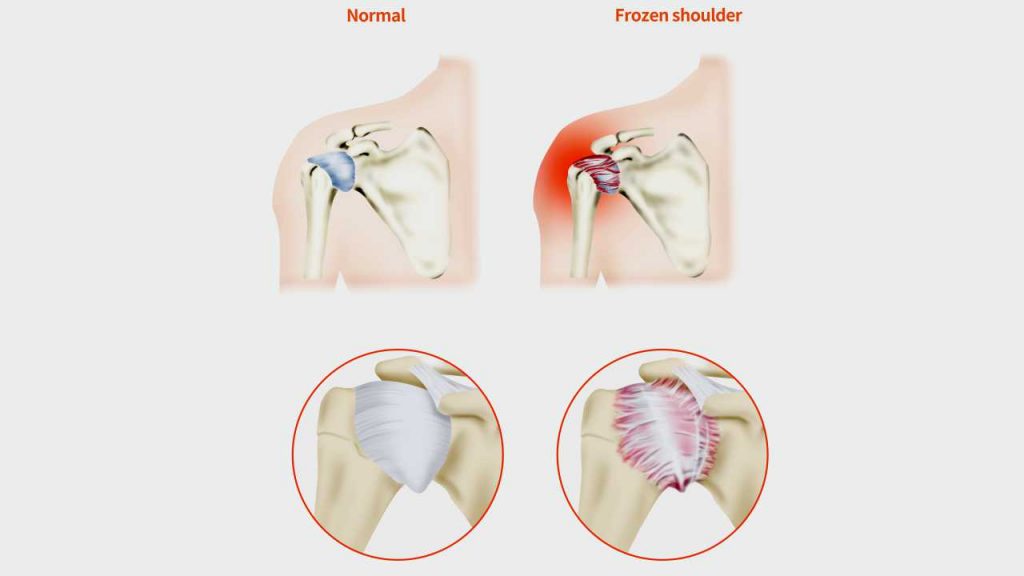
How Do You Deal with a Frozen Shoulder?

Frozen shoulder is a condition characterized by pain, stiffness, and reduced movements at the shoulder joint. It is commonly seen in the age group of 35 to 50 years and affects women more often than men.
What happens when you have a frozen shoulder?
The bones, tendons, and ligaments, which make up the shoulder joint are covered in a protective sheath called the capsule. During an episode of frozen shoulder, this capsule gets thickened and tightens around the joint. This leads to restriction in the movements of the joint. Very often the layers of the capsule get glued (adhere) to each other, and are called adhesive capsulitis.

Symptoms
Symptoms of frozen shoulder can be divided into three distinct stages during which the disease gradually reaches a peak and then wanes off. Each stage lasts for a few months, thus spreading the entire cycle of illness over a period of one to two years. These stages include:
1. Freezing (painful) stage
Early stage during which you may start having pain during all movements at the shoulder. The pain is usually worse at night and interrupts sleep. You will also notice reduction in the movements at the shoulder joint. For example, you will not be able to stretch your shoulder to pick up a jar from the top shelf, zip or button up on your back, or get a book from the adjacent table without having pain or putting in more effort.
2. Stiff (second) stage
This stage, which lasts from four months up to a year, is characterised with increased stiffness of the joint. The movements, which were possible in the first stage, become more restricted. The pain, however, starts to reduce a bit over time.
3. Frozen (recovery) stage
This is the stage of resolution when the stiffness and pain reduce significantly. The range of movement at the shoulder joint gradually improves, and so does the pain.
Also Read: Stress Fractures: Causes, Symptoms, and Treatment
Risks of a frozen shoulder
You might be at higher risk if you:
- Are a woman above 40 years of age
- Have any of the following conditions:
- Diabetes
- Thyroid (overactive or underactive)
- Tuberculosis
- Parkinsons
- Paralysis or stroke
- Injury at the shoulder joint
- Have undergone any surgery leading to prolonged immobilization of the shoulder joint, eg, surgeries on breast or for treatment of fractures of bones of the arm
Can you prevent a frozen shoulder from occurring in the first place?
In most cases, keeping the shoulder joint active prevents occurrence of a frozen shoulder or arrests its progression to a more severe form. If you do not have any symptoms of frozen shoulders, try and maintain the status quo by doing regular shoulder joint exercises. Consult your physician or a qualified instructor for an exercise regimen, which involves a wide range of movements at the joint.
Diagnosis and treatment
If despite taking precautions, you still develop a frozen shoulder, consult your doctor at the earliest. Do not forget to take all relevant medical documents along when you visit them.
Your doctor will most likely reach a diagnosis by taking the history of your symptoms and physical examination. An X- ray or MRI may be needed to reach a clear diagnosis in some cases. You might have to undergo tests for diabetes, thyroid, or other diseases, depending on the information gathered by your doctor.
Your doctor may prescribe painkillers initially, and recommend heat or cold application to the shoulder joint during acute flare-up. This may be done either at home using ice packs and hot water bottles. In a few cases, infrared lamps, short wave diathermy, or laser treatment machines may be used for this purpose.
Thereafter, you will be advised to do some exercises to slowly increase the range of motion at the shoulder joint. These exercises are best done under supervision of a qualified physiotherapist. Shoulder joint exercises increase the flow of fluid in the joint capsule and also help in breaking the glue-like adhesions in the capsule, thus helping with lubrication and reducing stiffness of the joint.
Alternate therapies
Acupuncture has been used for treatment of the condition. However, results are variable and differ from individual to individual. Electrical stimulation of nerves (TENS) may block the pain or release pain-relieving substances called endorphins. This technique has also shown promising results in some.
Will you have to undergo surgery for a frozen shoulder?
Most cases of resolve with painkillers and regular physiotherapy. Surgery as treatment is required in very few cases. Various surgical options resorted to for treatment are:
- Injecting steroid in the joint space
- Injecting sterile water in the joint space
- Manipulation of the joint under anesthesia
- Arthroscopic removal of scar tissue and adhesions from the joint space
Exercises for frozen shoulder
Most common exercises recommended for prevention and treatment of frozen shoulder are:
- Pendular stretch
- Arm circles
- Shoulder flexion
- Towel stretches
- Crossbody arm exercises
- Biceps stretch
- Wall crawlers
- Nautical wheel exercise
These exercises target various tendons and ligaments of the joint and increase the flow of fluid into the joint. Please consult your physician or a qualified exercise instructor before starting any exercise.
Also Read: Osteoporosis: Causes, Symptoms and How to Manage It
Can frozen shoulders recur?
In most cases, the frozen shoulder does not recur in the same shoulder after it has been resolved. However, some people may experience symptoms in the other shoulder after a few months.














